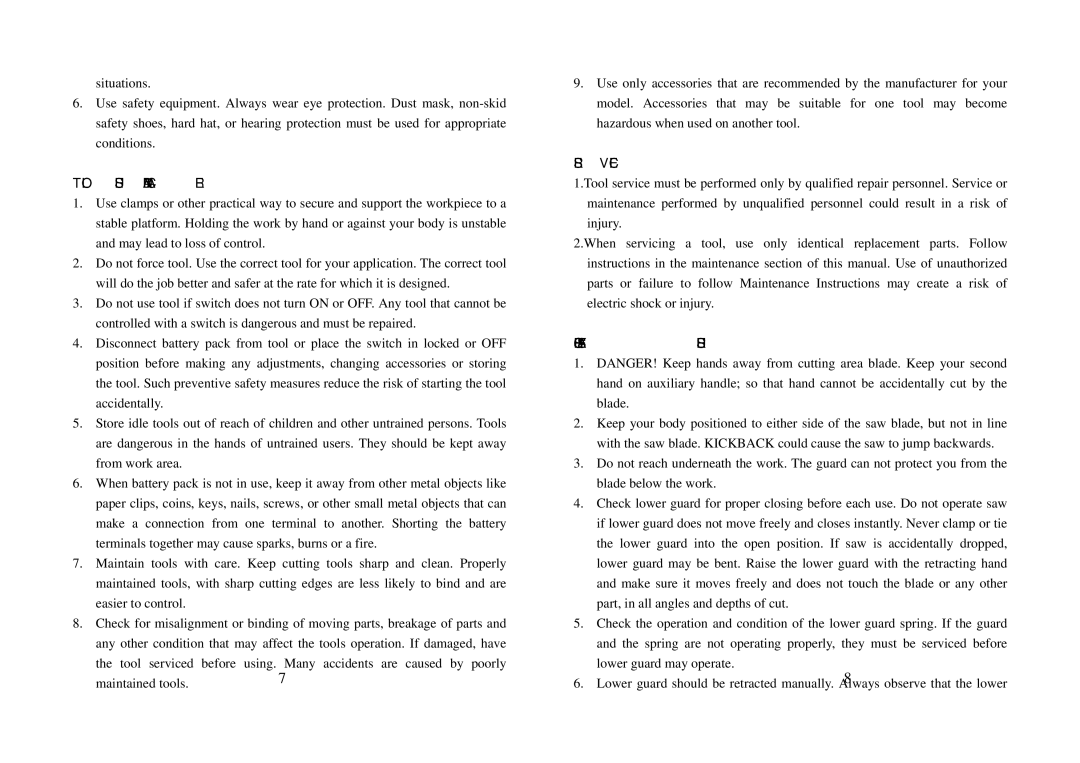situations.
6.Use safety equipment. Always wear eye protection. Dust mask,
TOOL USE AND CARE
1.Use clamps or other practical way to secure and support the workpiece to a stable platform. Holding the work by hand or against your body is unstable and may lead to loss of control.
2.Do not force tool. Use the correct tool for your application. The correct tool will do the job better and safer at the rate for which it is designed.
3.Do not use tool if switch does not turn ON or OFF. Any tool that cannot be controlled with a switch is dangerous and must be repaired.
4.Disconnect battery pack from tool or place the switch in locked or OFF position before making any adjustments, changing accessories or storing the tool. Such preventive safety measures reduce the risk of starting the tool accidentally.
5.Store idle tools out of reach of children and other untrained persons. Tools are dangerous in the hands of untrained users. They should be kept away from work area.
6.When battery pack is not in use, keep it away from other metal objects like paper clips, coins, keys, nails, screws, or other small metal objects that can make a connection from one terminal to another. Shorting the battery terminals together may cause sparks, burns or a fire.
7.Maintain tools with care. Keep cutting tools sharp and clean. Properly maintained tools, with sharp cutting edges are less likely to bind and are easier to control.
8.Check for misalignment or binding of moving parts, breakage of parts and any other condition that may affect the tools operation. If damaged, have
the tool serviced before using. Many accidents are caused by poorly
maintained tools. | 7 |
9.Use only accessories that are recommended by the manufacturer for your model. Accessories that may be suitable for one tool may become hazardous when used on another tool.
SERVICE
1.Tool service must be performed only by qualified repair personnel. Service or maintenance performed by unqualified personnel could result in a risk of injury.
2.When servicing a tool, use only identical replacement parts. Follow instructions in the maintenance section of this manual. Use of unauthorized parts or failure to follow Maintenance Instructions may create a risk of electric shock or injury.
SPECIFIC SAFETY RULES
1.DANGER! Keep hands away from cutting area blade. Keep your second hand on auxiliary handle; so that hand cannot be accidentally cut by the blade.
2.Keep your body positioned to either side of the saw blade, but not in line with the saw blade. KICKBACK could cause the saw to jump backwards.
3.Do not reach underneath the work. The guard can not protect you from the blade below the work.
4.Check lower guard for proper closing before each use. Do not operate saw if lower guard does not move freely and closes instantly. Never clamp or tie the lower guard into the open position. If saw is accidentally dropped, lower guard may be bent. Raise the lower guard with the retracting hand and make sure it moves freely and does not touch the blade or any other part, in all angles and depths of cut.
5.Check the operation and condition of the lower guard spring. If the guard and the spring are not operating properly, they must be serviced before lower guard may operate.
8
6. Lower guard should be retracted manually. Always observe that the lower
